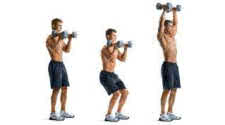Dumbbell Push Presses Exercise - Improve your Maximal Press Power

Explosive Exercise Reap the Benefits of Push Power for Presses
The terms power and strength are often used interchangeably, but wrongfully so. By applying the correct term to the following
entities, however, you'll go a long way toward understanding each: 1) A Roy Jones Jr. left hook to an opponent's noodle:
Power. 2) A 400-pound bench press by two-time Mr. Olympia Ronnie Coleman: Strength. 3) A 400-yard drive by golfer Tiger Woods:
Power. 4) Arm wrestling your training partner: Strength. As these examples illustrate, power is the display of force, or
strength, at high velocities. The more force you can move at fast speeds, the more powerful you are. For most athletes and the
strength coaches who train them, such displays of maximal power hold the key to performance.
Whereas most bodybuilding exercises work intermediary muscle fibers that can take on characteristics of either Type 1
(slow-twitch) or Type II (fast-twitch) fibers, power training works almost entirely the Type II variety, which are far more
capable of muscle growth than their Type I counterparts. Such movements also do a better job of enhancing neuromuscular learning
and control. To wit: More bodyparts and muscle fibers are recruited in one explosive lift, which requires very fast signaling
to those muscles from the nerves that enervate them. Unlike traditional bodybuilding-style training, which isolates muscles
and involves moving in a controlled manner, power training tends to be sports-specific, since most sports activities occur at
high velocities and involve multiple body segments and muscle groups.
The push press is a great exercise for developing maximal power. Like a standing barbell press, the exercise works your deltoids,
triceps, upper and lower trapezius, serratus anterior and spinal stabilizers. Yet the power element of the push press comes from
the fact that you begin the movement using your quads, glutes and calves - and to a lesser degree your hamstrings - as you
explode out of the bottom position. Explosion doesn't imply sloppy form; on the contrary, the key is to maintain perfect
structural integrity while using your body like a whip. In other words, the movement is initiated by the larger, more powerful
segments of your body and then transferred continuously to the smaller segments.
To get it right, follow these six steps:
1. Standing with slightly bent knees, hold a pair of dumbbells above and slightly outside your shoulders palms facing forward. Position your elbows out and away from your sides, pointing slightly down and forward.2. Using your legs like springs, rapidly bend your knees to just below the start position and then immediately contract your quads, glutes and calves to initiate an upward thrusting movement.
3. As you begin this thrust, simultaneously begin pressing the dumbbells overhead, rising on the balls of your feet to bring your heels - not the ground. Exhale through the most difficult portion of the lift.
4. As your arms reach full extension and you lock out your elbows, simultaneously bring your heels back down to the floor until you're standing flat-footed, holding the weights directly overhead, knees slightly bent and locked, back straight.
5. Hold this position momentarily before returning to the start position.
6. Pause for 1-2 seconds, inhale repeat for reps.